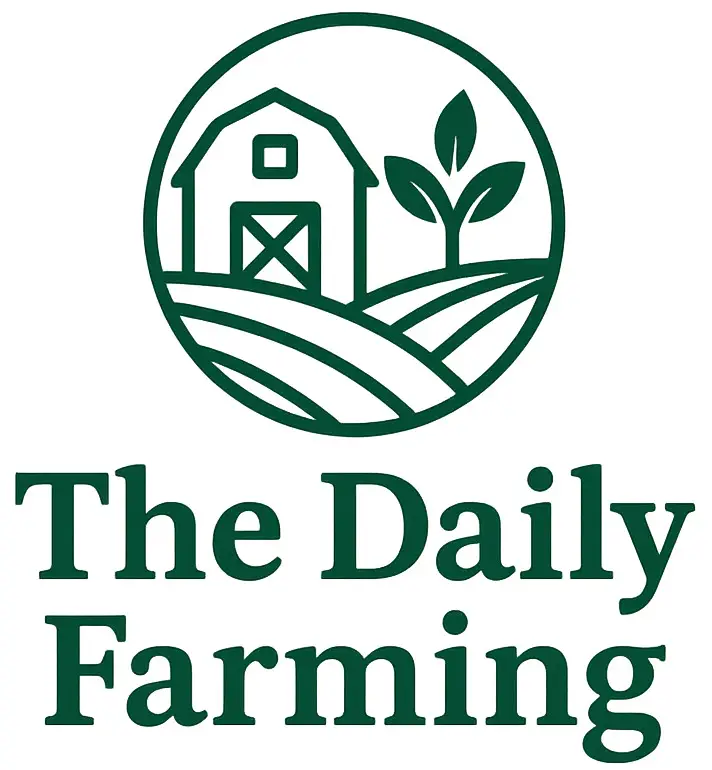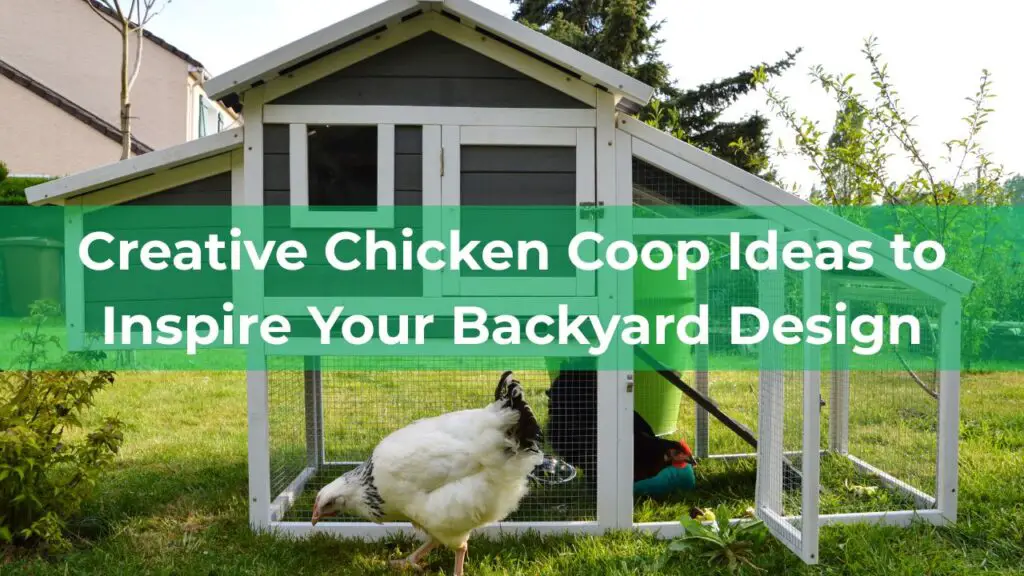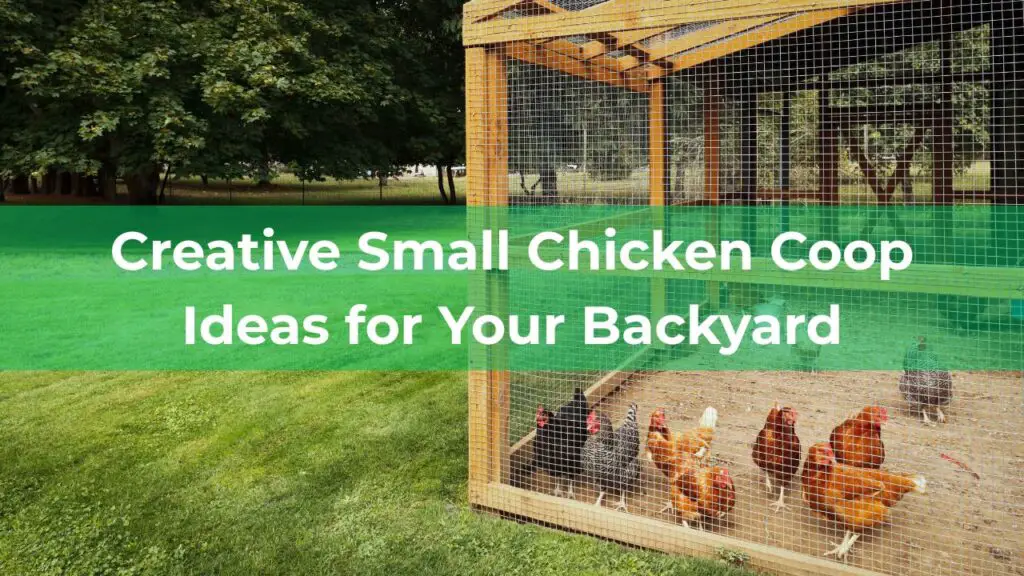Disclosure!
At The Daily Farming, your trust means everything. We use AI to help create some of our content, but every post is carefully reviewed and edited by real humans before it’s published.
Some of our images are AI-generated to help illustrate ideas, but everything you see is checked and approved by us.
Thanks for being here—we’re grateful for you!
So, you’ve got chickens—or maybe you’re just dreaming of fresh eggs and feathery companions clucking around your backyard. Either way, you’re probably learning fast: chickens are amazing… but they don’t just roam free without a little help. That’s where a chicken run comes in.
Think of it like their playground. A chicken run gives your flock space to stretch their legs, scratch around, soak up some sun, and stay safe from predators—all while keeping your garden from becoming a war zone of flying feathers and dug-up flower beds.
Now, we get it. Pre-built chicken runs? Pricey. And hiring someone to build one? Even pricier. But the good news? You don’t need to spend hundreds (or thousands) to give your chickens a secure, happy home.
This post is packed with 16 DIY chicken run cheap ideas you can actually build—many of them with materials you already have or can grab on the cheap. Whether you’re a weekend DIY warrior or a total newbie with a hammer, there’s something here for you.
And if you’re still working on the coop itself, don’t miss our other guide: 13 Creative Chicken Coop Ideas to Inspire Your Backyard Design. You’ll find plenty of inspiration to match your new run with the perfect home.
We’ll walk you through:
- Creative, budget-friendly chicken run ideas
- Materials you can use without maxing your credit card
- Answers to the most common chicken run questions
- Predator-proofing tips and design advice
- A few laughs and real talk along the way
Ready to build a run your chickens will love—without breaking the bank? Let’s dig in.
Things to Consider Before Building a Chicken Run
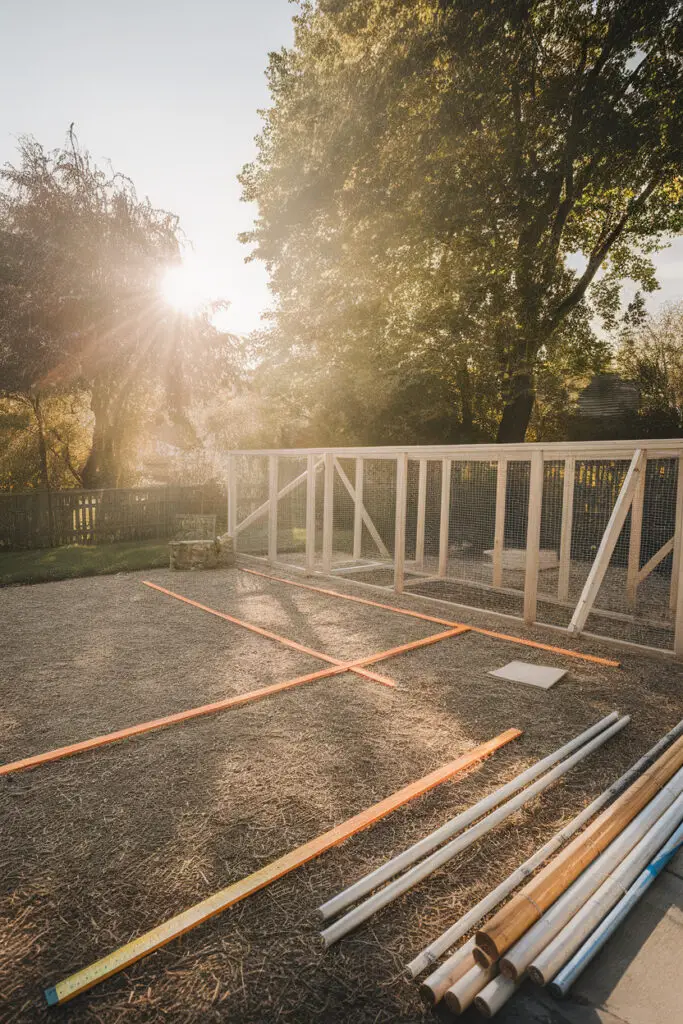
Before you start sawing pallets and zip-tying wire, take a breath. Building a cheap DIY chicken run isn’t just about slapping together fencing and hoping for the best. A little planning now? It can save you a ton of time, money, and heartbreak down the road.
How Many Chickens Do You Have?
This one’s huge. The number of chickens you have (or plan to have) will directly affect the size—and cost—of your run. More chickens mean more space, which means more materials. Skimping on space? That’s a fast track to stressed-out, bored birds. And that leads to bullying, feather picking, and fewer eggs.
Here’s a quick breakdown:
| Number of Chickens | Minimum Run Size (sq. ft.) | Recommended Run Size (sq. ft.) |
|---|---|---|
| 2–4 | 16–32 | 32–40 |
| 5–8 | 40–64 | 64–80 |
| 9–12 | 72–96 | 96–120 |
Tip: Aim for 8–10 square feet per chicken. Your flock will be happier, healthier, and way more productive.
➡️ If you’re still figuring out your coop size too, check out 17 Creative Small Chicken Coop Ideas for Your Backyard or 16 Affordable DIY Chicken Coop Designs for Your Backyard for coop plans that match your space and budget.
What Predators Live in Your Area?
You can build the prettiest chicken run in the neighborhood—but if it’s not secure? You’ve basically built a snack bar for local predators.
Common Backyard Chicken Predators (U.S.):
- Raccoons – Super smart. Known to open latches.
- Foxes & Coyotes – Quick, sneaky, and excellent diggers.
- Hawks & Owls – Silent assassins from the sky.
- Snakes – Love eggs and baby chicks.
- Neighborhood Dogs – Surprisingly common attackers.
To predator-proof your run:
- Bury hardware cloth or wire mesh 12 inches deep to stop diggers.
- Use strong latches and locks—skip the flimsy hooks.
- Cover the top with mesh, tarp, or metal panels to stop aerial attacks.
- Use hardware cloth (not chicken wire) for the first 3 feet of fencing.
“We lost our first hens to a raccoon that unzipped our mesh door. Lesson learned the hard way.” — Kelly R., backyard chicken keeper in Georgia
How Much Space Do You Have?
You don’t need acres to keep chickens. Even a tiny yard or narrow side lot can work with smart design.
Here are some small-space solutions:
- Limited yard? Use vertical space—add perches, platforms, or a second level.
- Long and narrow? Try a tunnel-style run that hugs your fence line.
- No grass? Build a chicken tractor (mobile run) and rotate it around.
The key is to design around your space, not try to force a prefab idea into it.
Permanent vs. Movable Runs
Should you build a run that stays put—or one you can move around the yard?
| Type of Run | Pros | Cons |
|---|---|---|
| Permanent Run | Very secure, handles weather well | Can damage lawn, harder to clean or relocate |
| Movable Run | Chickens get fresh grass, easy to clean | Less secure, usually smaller in size |
If you’re on a tight budget or short on tools, a lightweight movable run made from PVC, pallets, or a repurposed frame is a great place to start.
Local Weather (And How It Affects Design)
Weather can ruin even the best DIY run if you don’t build for your climate.
Tips Based on Your Climate:
- Rainy Areas: Use a sloped roof, elevate the coop, and dig drainage trenches.
- Cold Winters: Add windbreaks, and wrap the run in clear plastic in winter.
- Hot Climates: Prioritize shade, airflow, and water access.
- Windy Zones: Anchor your run using T-posts, sandbags, or concrete blocks.
“I thought a tarp would be enough until a Midwest storm shredded it overnight. Invest in better roofing if you’re in a storm-prone area.” — Jake T., Missouri homesteader
Building Permits or Zoning Laws (Yep, It’s a Thing)
Not fun, but important. Many cities (and especially HOAs) have rules about:
- How many chickens you can own
- Where you can build a coop/run
- Distance from property lines or neighboring homes
- Noise or smell restrictions
How to Check:
- Contact your city or county zoning office
- Check your town’s municipal website
- Look for “urban chicken ordinance” or similar language
- If you’re in an HOA, read the bylaws—twice
Skipping this step might mean tearing down your setup later. Or paying fines. Trust us—it’s worth checking before you start building.
Materials You Can Use for a Budget Chicken Run
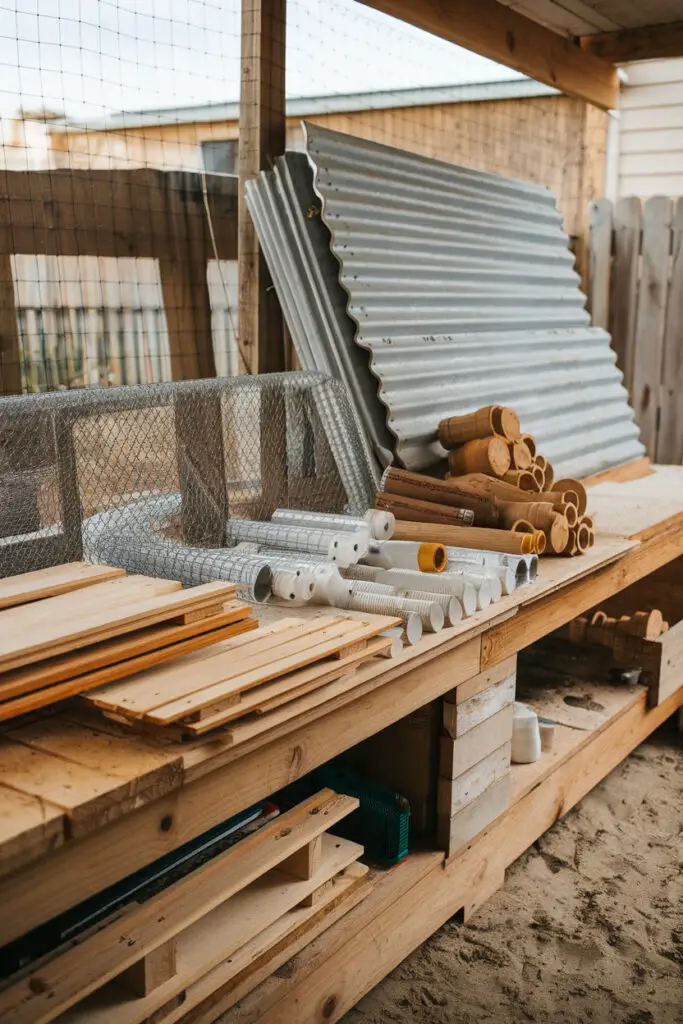
One of the biggest ways to cut down the cost of a chicken run is by choosing the right materials—ones that are affordable, durable, and ideally, already lying around your garage or backyard. A well-planned DIY chicken run doesn’t have to be expensive to be effective. You just need to know where to look and what to use.
Let’s break down some of the most popular, cheap (or even free!) materials people use to build budget-friendly chicken runs—and which ones are best for your specific needs.
Repurposed Wood and Pallets
When you’re trying to build a chicken run for cheap, nothing beats free wood—and pallets are a goldmine.
Why Pallets Work So Well:
- They’re easy to find (check construction sites, hardware stores, Craigslist)
- Most are made from hardwood, which is surprisingly durable
- Great for creating walls, frames, gates, and even small roofs
Case Study: A backyard chicken keeper in Oregon built an 8×10 foot chicken run using only free pallets from a local garden center. Total cost? Under $50—just for the hardware and wire.
Watch Out For:
- Chemically treated pallets: Look for “HT” (heat-treated) stamped on the wood—avoid any marked “MB” (methyl bromide).
- Rotting wood or exposed nails—always inspect before using.
Wire Fencing vs Chicken Wire vs Hardware Cloth
Wire is your run’s first line of defense. But not all wire is created equal—especially when it comes to keeping predators out.
| Type | Cost | Predator Protection | Durability | Best Use |
| Chicken Wire | Low | ✖️ Poor (raccoons can rip through) | Moderate | Temporary pens or top covers |
| Welded Wire Fencing | Moderate | ✅ Good (stronger mesh) | High | Run walls and fencing |
| Hardware Cloth | High | ✅✅ Excellent (rodent- and digger-proof) | Very High | Bottom 2-3 feet of fencing; burying |
“Chicken wire keeps chickens in, but it doesn’t keep predators out.” — Backyard Chicken Forum
Pro tip: If you’re on a tight budget, use chicken wire for the top and hardware cloth only on the bottom 3 feet—that’s where most attacks happen.
T-Posts and U-Posts
T-posts (also called fence posts or steel stakes) are a fast, cheap way to set up a sturdy frame for your chicken run without digging holes or pouring concrete.
Why They’re Great:
- Easy to hammer into the ground
- Last for years (they’re galvanized steel)
- Work well with zip-ties, fencing clips, or wire
Cost Breakdown:
- U-Posts: ~$2–$4 each (lighter, easier for smaller runs)
- T-Posts: ~$5–$8 each (heavier duty, best for windy areas)
Need a quick build? Use T-posts + welded wire fencing + zip ties for a predator-resistant, tool-light setup.
PVC Pipes and Connectors
PVC is one of the most underrated materials for cheap chicken runs. It’s lightweight, flexible, and incredibly easy to work with, even for beginners.
PVC Pros:
- Great for building movable chicken tractors
- No special tools needed—just cut, connect, zip-tie
- Weather-resistant and easy to clean
Ideal Uses:
- A-frame run skeletons
- Portable tunnels or temporary pens
- Shade structures or enclosed mini-runs
Tip: Use 1-inch or thicker pipe for better durability and less wobble.
Zip Ties, Screws, and Other Cheap Fasteners
Don’t overlook the small stuff—your choice of fasteners can make a big difference in stability, especially if you’re using repurposed materials.
Must-Have Fasteners:
- Heavy-duty zip ties (buy in bulk—look for UV-resistant)
- Galvanized screws (for any wood connections)
- Staple gun and staples (to attach wire mesh)
- U-nails or fencing clips (for attaching wire to posts)
Budget Tip: You can often find big bags of screws or zip ties at habitat for humanity stores, garage sales, or clearance bins at home improvement stores.
Recycled Doors, Windows, or Frames
Adding a functional gate or window doesn’t have to mean buying new. Old cabinet doors, window frames, or even broken screen doors can all be reused.
Where to Look:
- Facebook Marketplace
- Habitat ReStores
- Dumpsters (you’d be surprised)
- Construction site leftovers
Smart Use Cases:
- Old windows: Cut out the glass, attach wire mesh—voilà, instant vented panel
- Doors: Use as an easy-access run entrance or coop gate
- Wooden frames: Reinforce with hardware cloth for panels or shade
Tarps for Shade or Rain Protection
Chickens need shade in summer and dry ground in winter. A cheap tarp does both.
Benefits of Using Tarps:
- Cost-effective roofing
- Easy to install and replace
- Can be used as windbreaks
Tarp Tips:
- Use grommeted tarps for easier securing
- Always tilt for drainage—no one wants a chicken run swamp
- Go with UV-resistant tarps if your area gets a lot of sun
“We got a 10×12 tarp from Harbor Freight for $5 and stretched it over a pallet frame—instant weatherproof chicken run.” — DIY Backyard Chicken Keeper
Quick Reference: Budget Chicken Run Materials Cheat Sheet
| Material | Best For | Average Cost | Where to Find |
| Repurposed Wood/Pallets | Frame, walls | Free – $20 | Craigslist, stores, dumpsters |
| Chicken Wire | Top cover, temporary use | $10 – $20/roll | Hardware stores |
| Hardware Cloth | Bottom fencing, predator proofing | $30 – $50/roll | Home Depot, online |
| PVC Pipes | Portable run frames | $1 – $3 per pipe | Plumbing supply, big box stores |
| T-Posts/U-Posts | Structural support | $2 – $8 each | Tractor Supply, Lowes |
| Zip Ties & Screws | Fastening everything together | $5 – $15 bulk packs | Amazon, hardware stores |
| Tarps | Roofs, shade, wind/rain protection | $5 – $25 | Harbor Freight, Walmart |
16 DIY Chicken Run Cheap Ideas
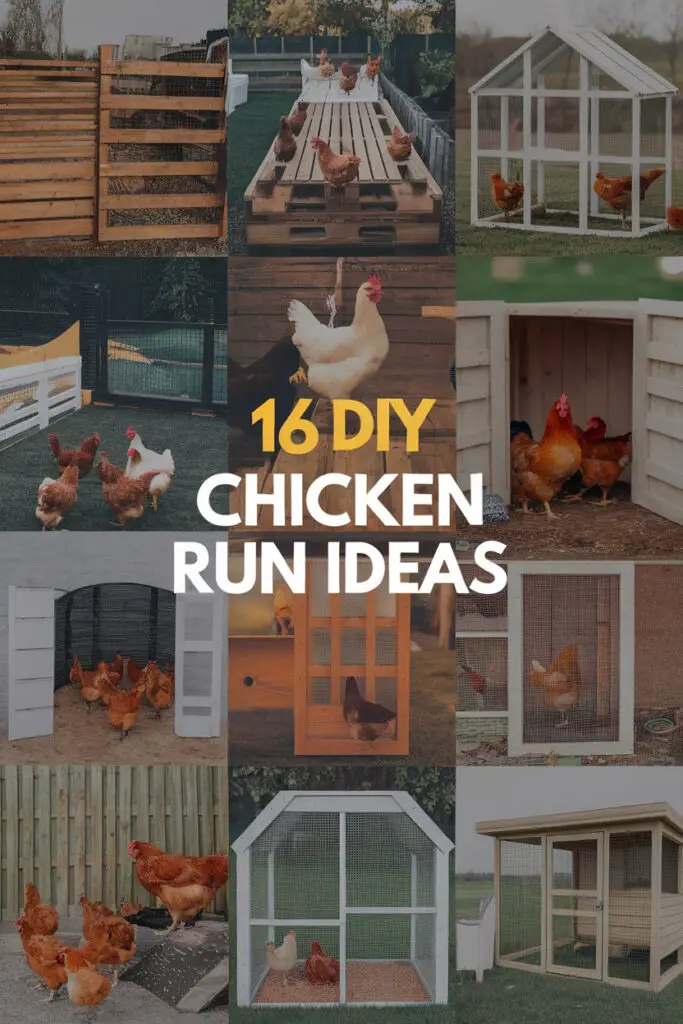
Building a chicken run doesn’t have to drain your wallet. In fact, with a little creativity and resourcefulness, you can build a secure, functional, and even stylish chicken run using mostly repurposed or low-cost materials. Here are 16 DIY chicken run cheap ideas—each with its own benefits, cost range, and practical tips.
1. Pallet Chicken Run
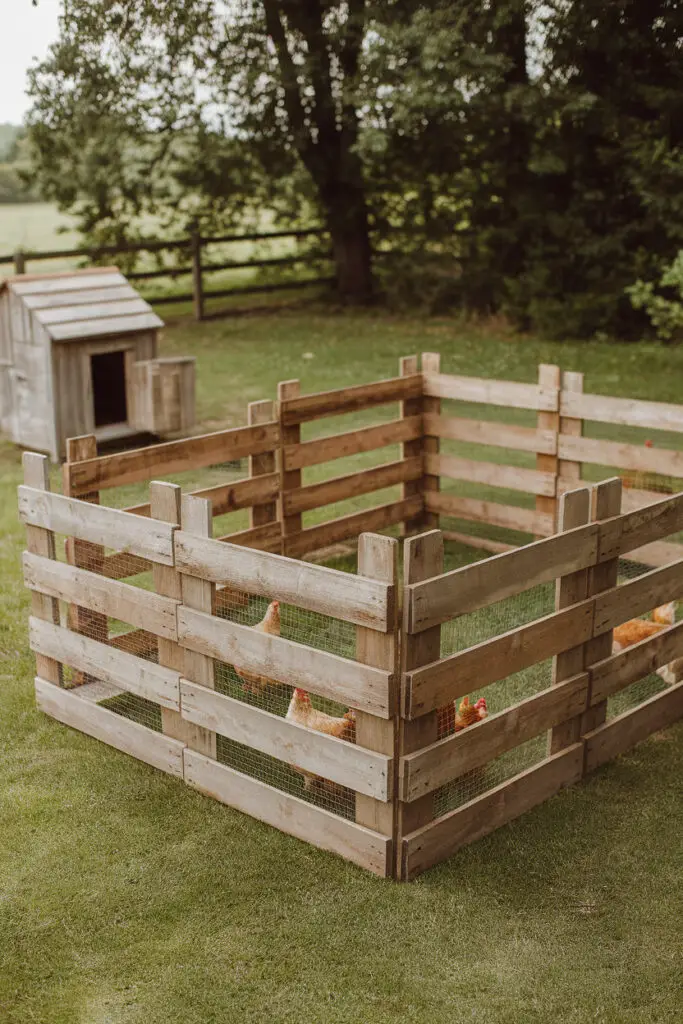
If you’re after a chicken run that’s both budget-friendly and surprisingly sturdy, pallets are a top-tier choice. With a little creativity and some elbow grease, you can turn free wood pallets into strong walls, gates, or even roof supports for your chicken run.
Think of pallets like building blocks for backyard projects—they’re durable, often treated for outdoor use, and best of all, usually free.
Description:
This DIY chicken run uses upright wood pallets fastened together to form the frame or walls of the run. Some people also use them as the base for a roof frame or side enclosures.
Want to create a complete pallet-based setup? Pair this run with these Chicken House Ideas or build a cozy sleeping zone using ideas from Our 14 hicken Roost Ideas.
Estimated Cost: $0 – $50
Where to Get Pallets:
- Hardware stores
- Garden centers
- Craigslist or Facebook Marketplace
- Construction sites
Pros:
- Free or very cheap
- Sturdy structure
- Eco-friendly (upcycled)
Cons:
- Can be heavy to move
- May require sanding or treatment
Tips:
- Look for heat-treated pallets marked with “HT” (avoid ones labeled “MB”)
- Add hardware cloth to the inside to increase predator protection
2. PVC Pipe Chicken Run
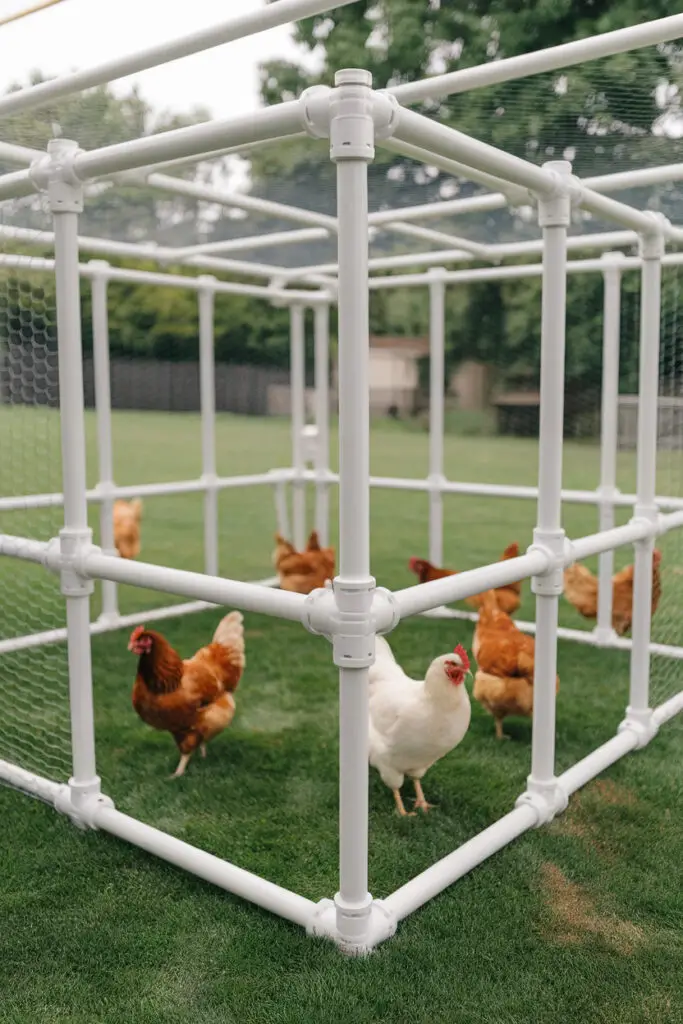
Description: Use PVC pipes and connectors to build a lightweight, movable run. Ideal for small flocks or urban setups where portability matters.
Estimated Cost: $30 – $100
Pros:
- Lightweight and portable
- Easy to assemble and disassemble
- Won’t rust or rot
Cons:
- Less sturdy in high-wind areas
- Not suitable for large, heavy-duty builds
Tips:
- Use 1″ or thicker pipe for durability
- Add cross-bracing with zip ties to prevent sagging
“I built a 6×10 PVC chicken tractor in two afternoons for just $45. It’s been great for letting the hens graze fresh grass every day.” – Backyard DIY’er, Ohio
3. Trampoline Frame Chicken Run
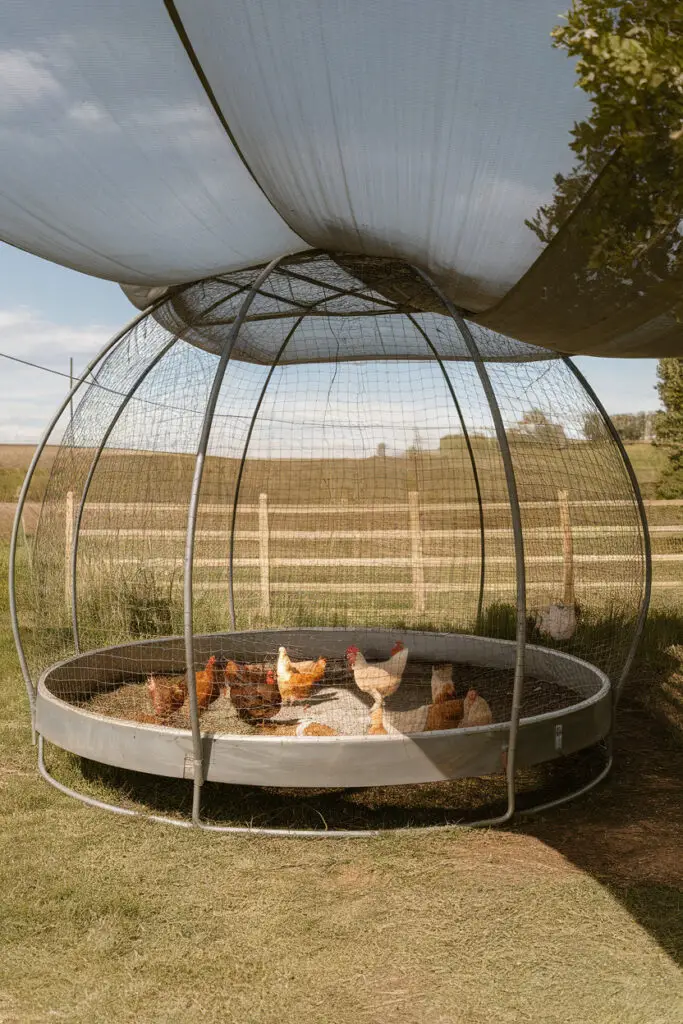
Description: Convert an old trampoline frame into a curved, dome-style chicken run. Just add wire fencing and a tarp over the top.
Estimated Cost: $50 – $150 (less if you already have a trampoline)
Pros:
- Very sturdy steel frame
- Circular/curved shape gives more headroom
- Upcycles junk that might otherwise go to landfill
Cons:
- Tricky to modify if pieces are rusted or warped
- May need cutting tools to remove legs
Tips:
- Add zippered tarp panels for easy access
- Reinforce lower 2 feet with hardware cloth for predator defense
4. Dog Kennel Chicken Run
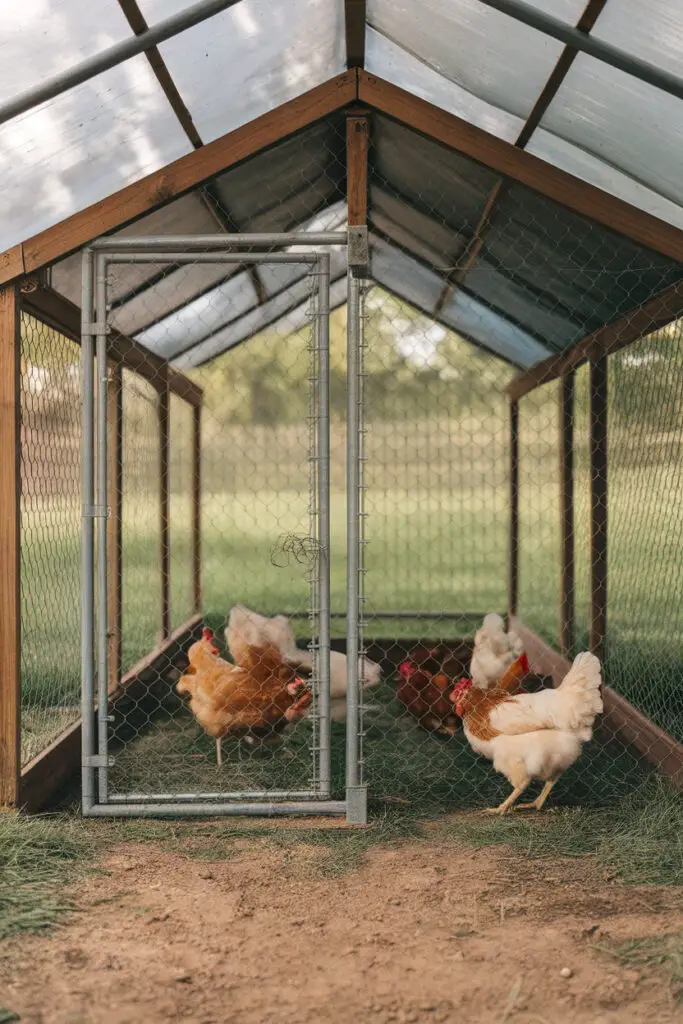
Description: Repurpose an old chain-link dog kennel into a predator-resistant chicken run. Add a coop inside or attach to one.
Estimated Cost: $100 – $300 (cheaper if bought secondhand)
Pros:
- Durable and secure
- Often comes with a built-in gate
- Easy to set up
Cons:
- Chain-link won’t stop smaller predators (use hardware cloth at bottom)
- Can be expensive if bought new
Tips:
- Look for deals on Craigslist or farm auctions
- Add a tarp on top for shade and rain protection
Quote: “I bought a used kennel on Facebook for $75 and turned it into a chicken fortress. No predator has made it through in over two years.” — Sarah, homesteader in Tennessee
5. Greenhouse Frame Chicken Run
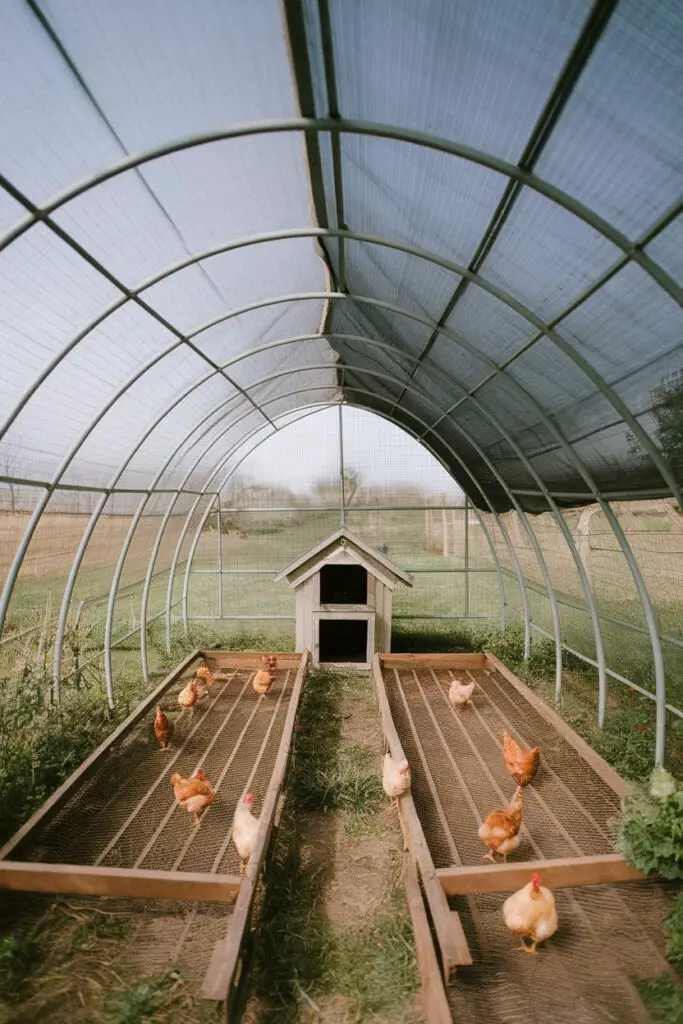
Description: Repurpose an old greenhouse frame to form the skeleton of your chicken run. Cover with wire mesh and use shade cloth or a tarp overhead.
Estimated Cost: $50 – $150
Pros:
- Curved shape allows for great interior height
- Easily supports tarp or netting for weather protection
- Great for warm or wet climates
Cons:
- Not as strong as steel or wood frames
- May require anchoring to prevent wind lift
Tips:
- Use UV-resistant netting or tarps to cover
- Reinforce corners with metal brackets or T-posts
6. Portable A-Frame Run
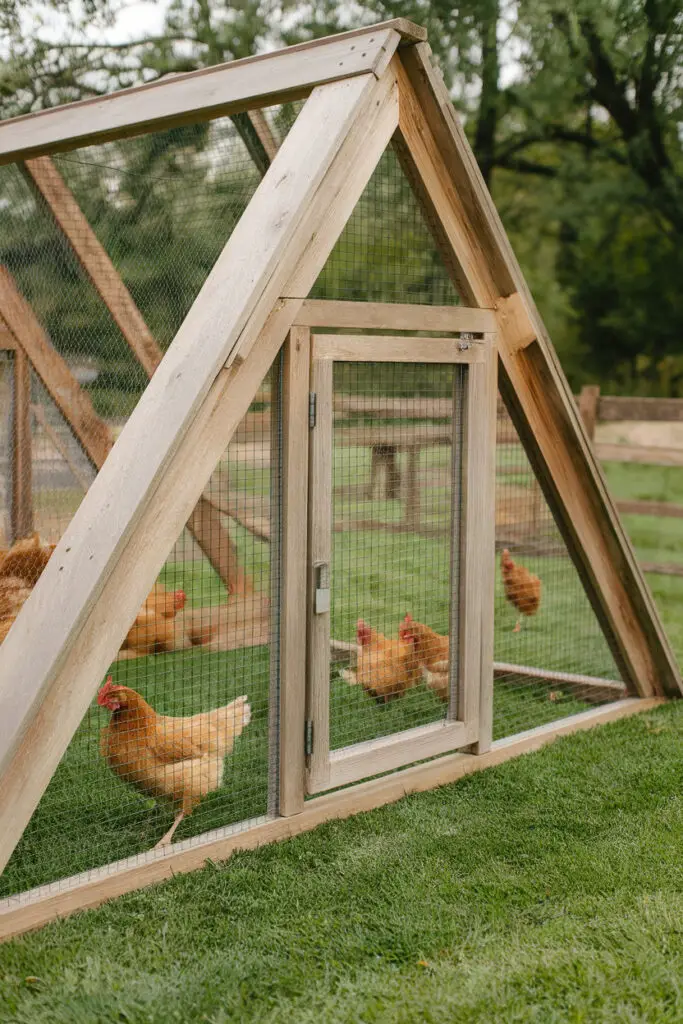
Description: This triangular, A-frame structure is perfect for rotating pastures or temporary enclosures. It’s lightweight, easy to build, and perfect for two to five chickens.
Estimated Cost: $40 – $100
Pros:
- Portable and easy to move
- Good for grass rotation (reduces waste buildup)
- Ideal for small yards
Cons:
- Limited space inside
- May not be ideal for permanent setups
Tips:
- Add wheels or handles for better mobility
- Combine with a small raised coop for extra space
Materials Used:
- 2×4 lumber
- Hinges, handles, mesh
- Screws or nails
- Optional: wheels from old lawnmowers or carts
Fun Fact: A-frames can also be used as duck tractors or rabbit runs, making them great multi-use structures.
7. Garden Fence Panels
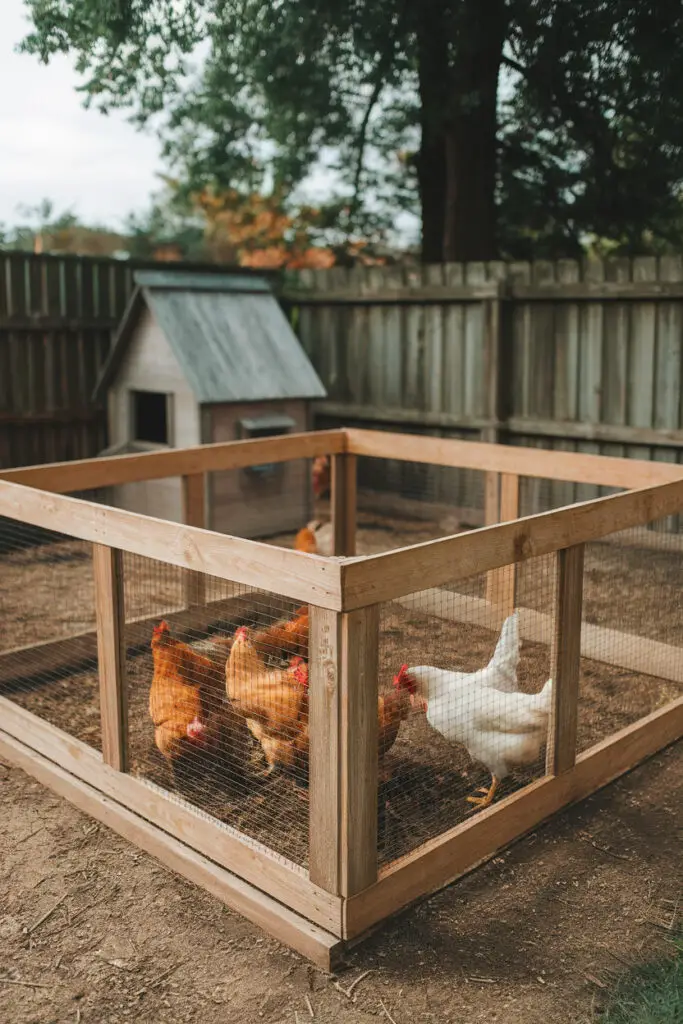
Description: Reuse old garden fence panels or purchase cheap, pre-made panels to create a simple chicken run. Just arrange them in a rectangular or square formation, depending on the available space.
Estimated Cost: $30 – $100 (depending on whether you repurpose or buy panels)
Pros:
- Easy to move and set up
- Affordable
- Can be purchased in various sizes
Cons:
- Not as predator-proof unless reinforced
- Limited aesthetic options
Tips:
- Opt for wooden fence panels if you can find them secondhand, or metal panels for more durability.
- Ensure low gaps near the ground to prevent small animals from entering.
8. Cattle Panel Chicken Run
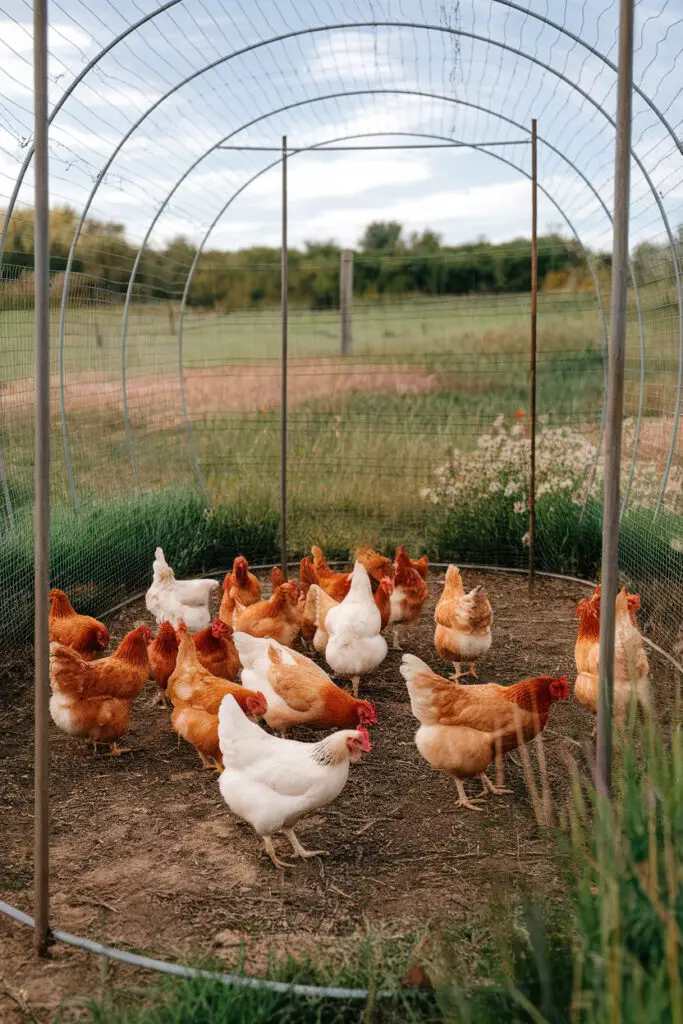
Description: Cattle panels, which are strong, wire fencing used in livestock pens, work perfectly for building a chicken run. They are sturdy, affordable, and can easily be bent into arches to form a durable, curved structure.
Estimated Cost: $40 – $120
Pros:
- Extremely strong and predator-resistant
- Great for large or aggressive flocks
- Long-lasting
Cons:
- Not as easy to move as PVC or wood
- Requires more tools to shape and secure the panels
Tips:
- Use T-posts to anchor the panels securely into the ground
- Add a roofing tarp to protect chickens from the elements
9. Chicken Tractor
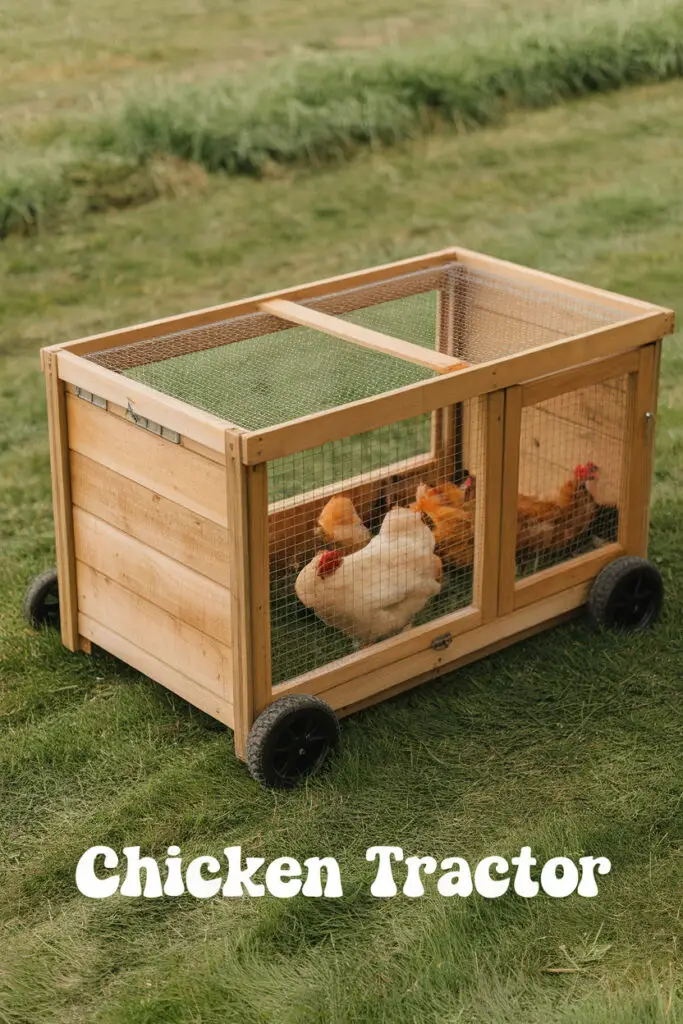
Description: A chicken tractor is a movable coop and run combo that allows your chickens to roam on fresh grass daily. It’s lightweight and perfect for smaller flocks that benefit from rotational grazing.
Estimated Cost: $50 – $200
Pros:
- Provides fresh grass and insects for chickens
- Moves easily for rotational grazing
- Can double as a mobile coop
Cons:
- Limited space for larger flocks
- Needs to be moved regularly
Tips:
- Ensure your chicken tractor is secure and predator-proof, especially at night.
- Add a wire floor to protect chickens from predators if moving through high-risk areas.
10. Old Window/Screen Frame Run
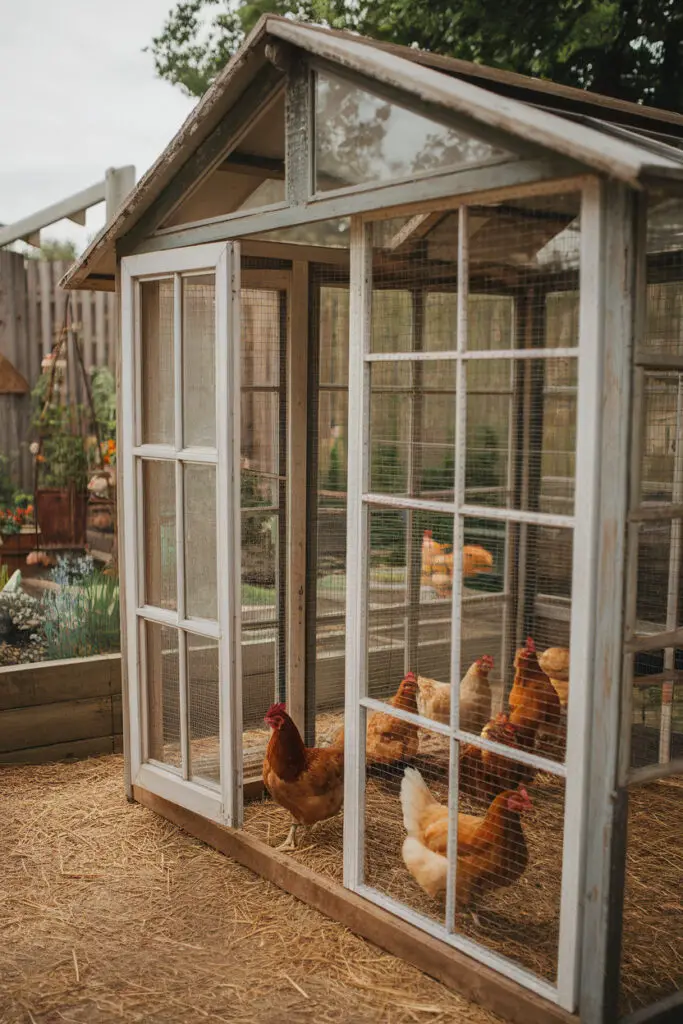
Description: Use old window or screen door frames from junkyards or salvage yards. Add wire mesh to create a simple yet functional chicken run. These frames are often available for free or at low cost.
Estimated Cost: $20 – $60 (depending on how many windows/frames you can salvage)
Pros:
- Super budget-friendly (especially if using free materials)
- Vintage farmhouse aesthetic
- Easy to build
Cons:
- Frames may not be as sturdy as other materials
- Can be difficult to find enough frames
Tips:
- Reinforce the corners with wooden posts to keep the structure secure.
- Consider repurposing the windows as nesting boxes or ventilation openings.
11. Wood Frame & Chicken Wire Run
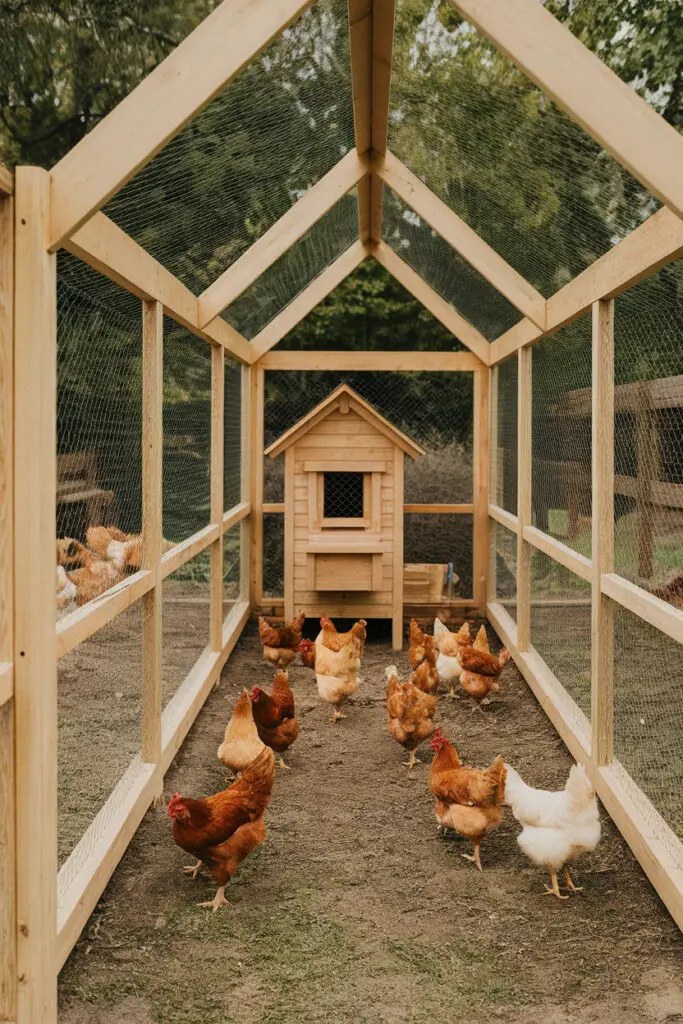
Description: A wood frame with chicken wire is a classic DIY chicken run design. It’s simple, effective, and relatively easy to build. You can customize the size and shape to fit your available space and needs.
Estimated Cost: $50 – $150
Pros:
- Customizable to any size
- Easy to expand later on
- Good predator protection with additional chicken wire
Cons:
- Requires some woodworking skills
- Needs to be securely anchored to avoid predators lifting the wire
Tips:
- Use pressure-treated wood for the frame to resist rotting.
- Reinforce corners with extra screws or brackets to prevent sagging.
12. Upcycled Tent Frame Run
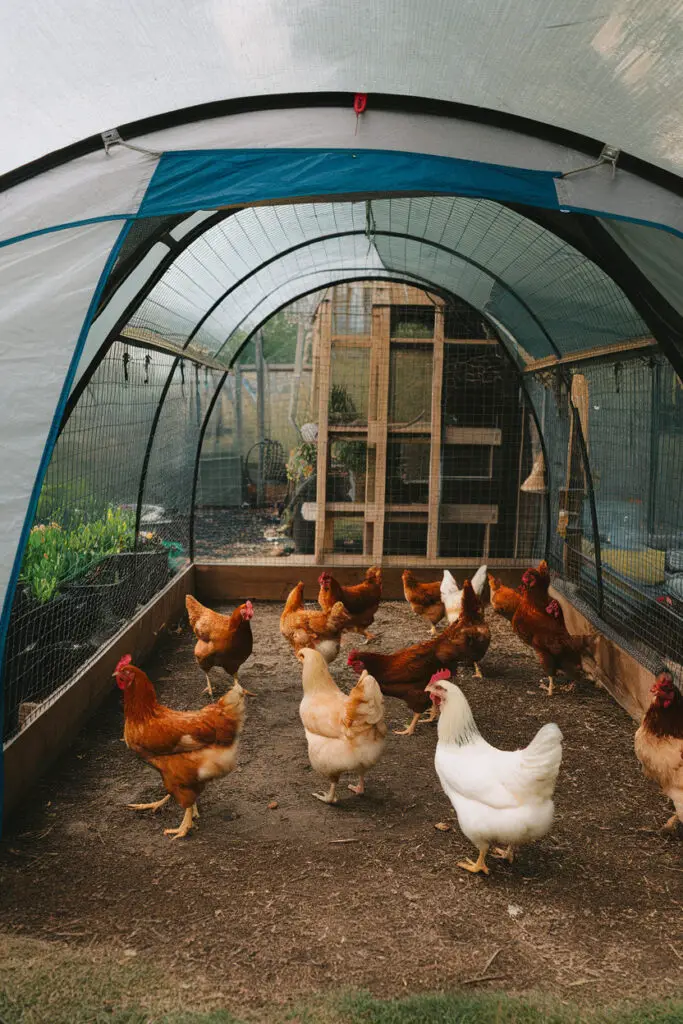
Description: Turn a broken pop-up tent frame into a chicken run by adding mesh or chicken wire. It’s an ideal project if you have an old, unusable tent in the garage. Use tarps for extra weather protection.
Estimated Cost: $30 – $100
Pros:
- Great for quick, temporary runs
- Easy to set up and move
- Flexible design (add tarps for shade or rain protection)
Cons:
- Not as sturdy as permanent structures
- Windy conditions can be a challenge
Tips:
- Add PVC pipes to reinforce the frame if necessary.
- Use the tent material as extra coverage to protect your chickens from rain and sun.
13. Reclaimed Door Frame Run
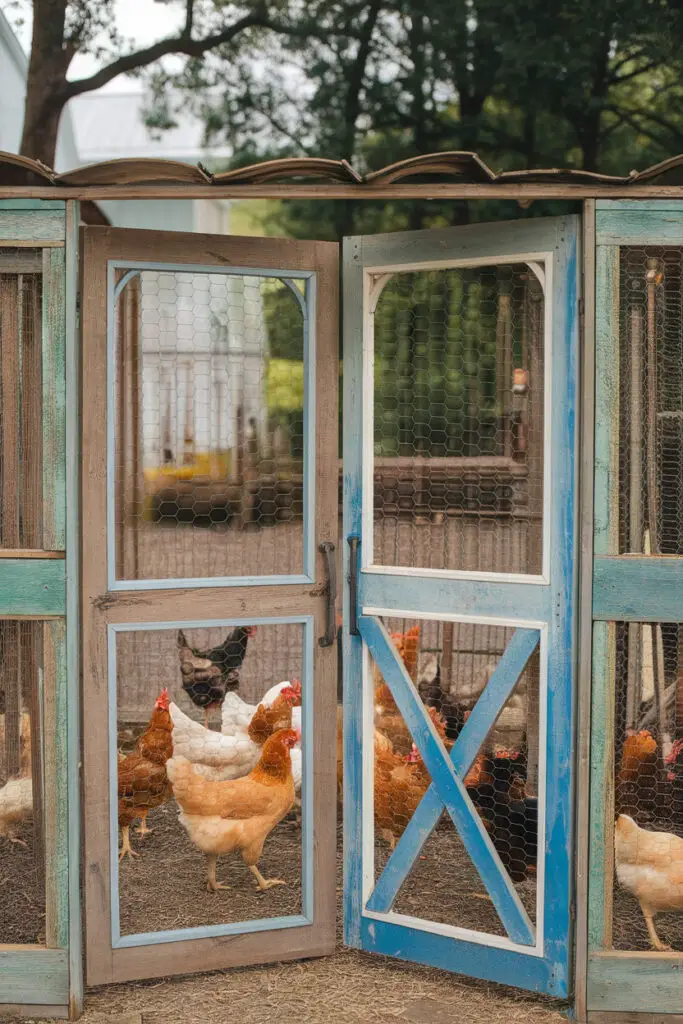
Description: Reclaim old doors from junkyards or used furniture stores and repurpose them into gates or wall supports for your chicken run. Combine multiple doors for a full enclosure.
Estimated Cost: $10 – $50 (depending on door availability)
Pros:
- Rustic farmhouse aesthetic
- Doors can function as gates for easy access
- Recycles old materials
Cons:
- Limited by the number of doors available
- May require some modification to secure doors properly
Tips:
- Use wooden doors for a classic look, but metal doors might be better for extra security.
- Add latches or locks for better predator protection.
14. Simple T-Post and Mesh Run
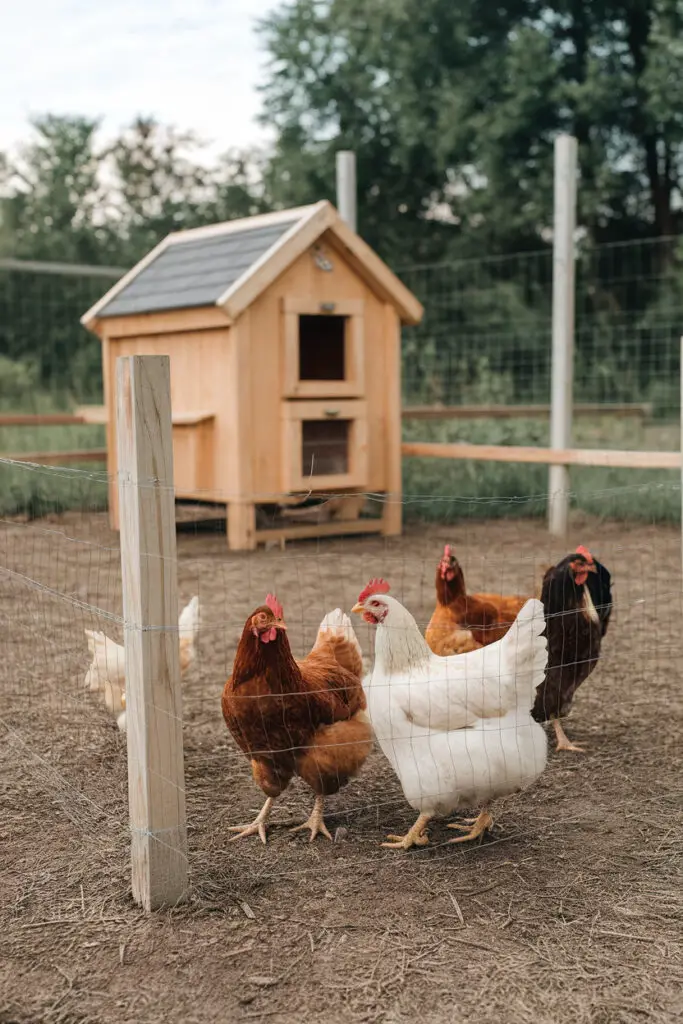
Description: This is one of the easiest and quickest chicken run ideas: simply drive T-posts into the ground and wrap mesh fencing around them. It’s affordable, functional, and simple to install.
Estimated Cost: $30 – $70
Pros:
- Fast and inexpensive
- Easy to adjust and expand
- No need for complex tools
Cons:
- May not be as durable over time
- T-posts need to be driven deeply into the ground
Tips:
- Use T-post caps to avoid injuries to your chickens.
- Secure the mesh with zip ties for easy adjustments.
15. Corrugated Metal Panel Run
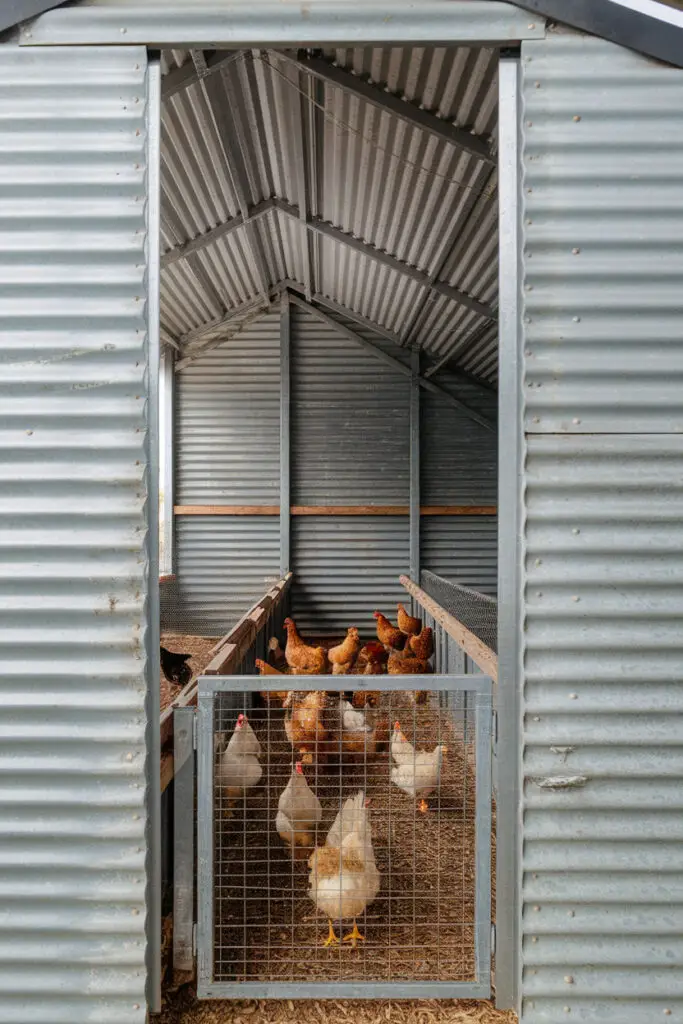
Description: Use corrugated metal panels (usually roofing panels) to form the walls or roof of your chicken run. These are strong, weather-resistant, and durable.
Estimated Cost: $50 – $150
Pros:
- Wind and predator-resistant
- Very durable
- Provides shade from the sun
Cons:
- Can be difficult to work with (heavy and sharp edges)
- May require additional framing for stability
Tips:
- Use rubber gaskets or weatherproofing tape to seal any gaps.
- Ensure the metal is secured tightly to avoid wind or predator damage.
16. Mixed-Materials Frankenstein Run
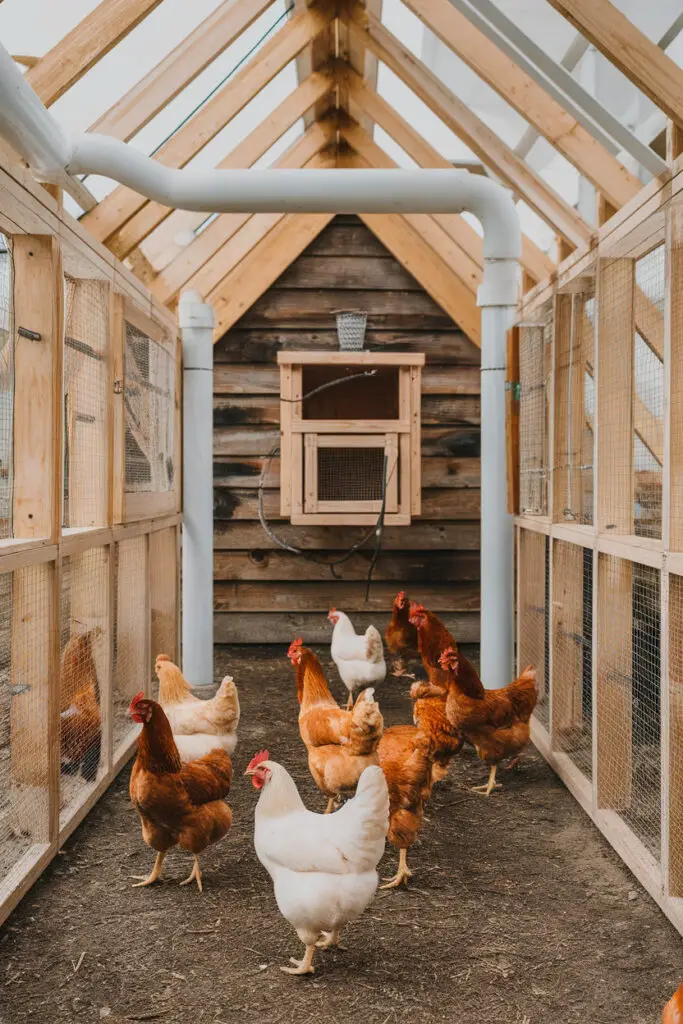
Description: The Frankenstein run is a fun, creative project where you combine whatever materials you have on hand: wood, PVC pipes, wire, old fencing, or even recycled pallets.
Estimated Cost: $0 – $100 (depends on what materials you have)
Pros:
- Maximal creativity with minimal cost
- Can use leftover or junk materials
- Customizable design
Cons:
- Requires creative thinking and extra effort
- May not be as uniform or aesthetically pleasing
Tips:
- Make sure the run is secure and predator-proof.
- Focus on functionality over perfection—it’s about making the most of what you have.
Common Mistakes to Avoid When Building a Cheap Chicken Run
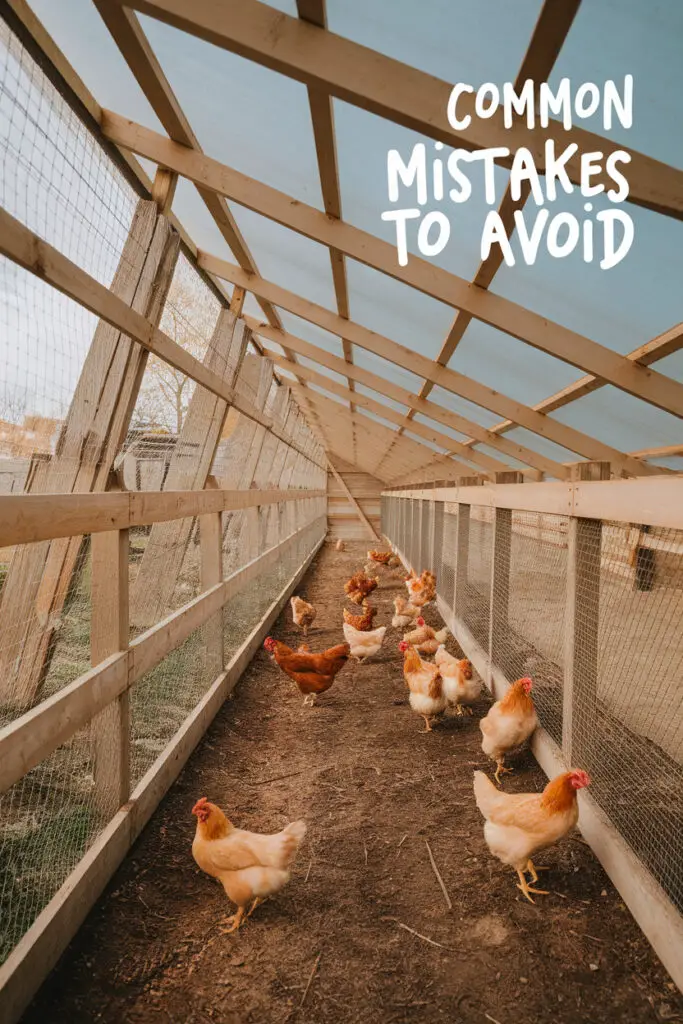
Building a cheap chicken run is a great way to keep your chickens safe without breaking the bank. But, believe me, it’s easy to make some rookie mistakes that could cost you in the long run. Let’s break down the most common ones so you can avoid them and create a safe, durable space for your chickens to roam.
1. Using Weak Materials
Mistake: So, you’re trying to save money on materials. Totally get it! But, cheap doesn’t always mean good. Using weak materials might seem like a win, but it can lead to disaster down the road.
Why It’s a Problem: Thin wood or flimsy wire can wear down quickly. One good storm or a curious raccoon, and you might find yourself with a busted chicken run. And that means more repairs… or worse.
Solution:
- Opt for sturdy materials—don’t skimp where it counts. Hardware cloth is your best friend for predator protection. It’s stronger than chicken wire and more durable.
- If you’re using wood, go for pressure-treated lumber. It’s designed to resist rot and weathering, so your frame stays strong.
- Recycled materials can work, but check their quality before using them. Nothing worse than building something you thought would last, only to have it fall apart in a few months.
2. Skipping Predator Protection
Mistake: If you’re not thinking about predator-proofing your chicken run, you’re asking for trouble. Sure, chickens are cute, but predators think they’re dinner. And they’re creative about how they get in.
Why It’s a Problem: Predators don’t need much. Just one little gap or weak point, and your chickens are at risk. It’s heartbreaking, and you definitely don’t want to be fixing a run that’s been breached.
Solution:
- Hardware cloth is a must-have. It’s tough and hard for even the sneakiest critters to get through.
- Make sure you cover the top of your run, too—hawks and other birds of prey can swoop down without a second thought.
- Regularly check for weak spots. Even the smallest hole can become a big problem for your flock.
3. Not Anchoring the Frame
Mistake: When you’re in DIY mode, anchoring might seem like an afterthought. But trust me, if you don’t anchor your run properly, you’ll regret it.
Why It’s a Problem: High winds, curious animals, or even your chickens’ own movements can knock over a poorly anchored run. And if it tips over, your chickens might be out of luck.
Solution:
- Secure your run to the ground with T-posts, stakes, or even concrete if you want something more permanent.
- For portable runs, make sure they’re light enough to move, but still heavy enough to resist tipping.
- Consider anchoring your tarps or roofs, too. Wind can really do a number on them if they’re not secured.
4. Forgetting Access for Cleaning
Mistake: Here’s a big one: forgetting about access points. You’ll be spending time in that run, so make sure you can get in and clean it up!
Why It’s a Problem: A run that’s hard to get into means cleaning it will be a pain. And trust me, chickens can make a mess—bedding, droppings, feed, and more. If you can’t clean easily, it’ll lead to a build-up of bacteria and pests. Yuck!
Solution:
- Build large access doors or lids to make it easier to get in and out for cleaning.
- Hinged or sliding roofs work great for making maintenance a breeze.
- Consider making removable floor panels for easy cleaning. That way, you don’t have to wrestle with the whole floor every time.
- Easy access = happy chickens and a much easier cleanup!
Bonus Tip: Regularly Inspect Your Run!
Once you’re done building, don’t just forget about it. Keep an eye on your chicken run to catch any issues before they become a big problem. A few minutes of checking here and there could save you a lot of headaches later.
